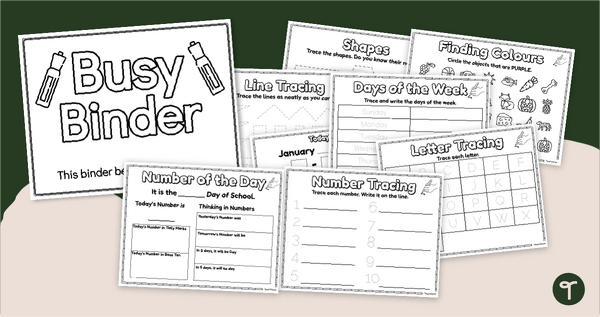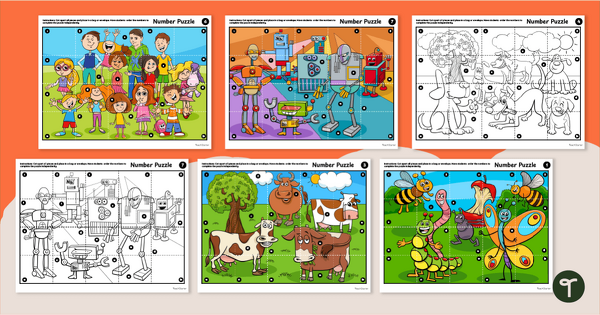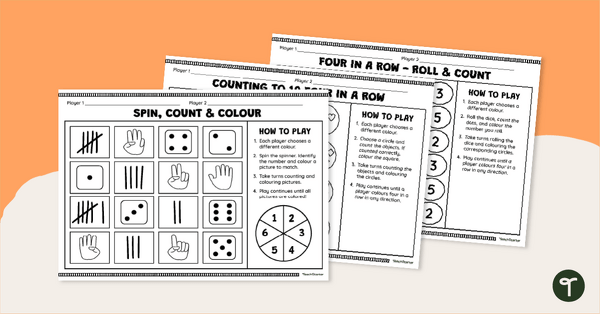Counting Teaching Resources
Teach counting skills this school year with printable worksheets, educational games, digital activities and more primary school resources designed to help students when they are learning to count.
This extensive collection of teaching resources aligned to the Australian curriculum includes maths mentals, MAB flashcards and more to save primary teachers time on lesson planning. Created by expert teachers, each resource in this maths collection has been carefully reviewed and curated by our team. That means it's ready to use in the classroom! You'll even find editable resources, plus differentiated options.
New to teaching counting, or just looking for fresh ways to engage your students? Read on for a primer from our teaching team!
What Is Counting?
It may seem obvious, but let's start at the beginning.
The basic counting process involves a one-to-one correspondence between the items in the set and the counting numbers. It's a fundamental mathematical concept taught in the early years that helps our students develop number sense and mathematical skills.
In the early years, students typically learn to:
- Recite the numbers in sequence
- Count objects by pointing to them and saying the corresponding number
- Recognise and write numerals
- Count forward and backward
- Skip count by twos, fives and tens
- Use counting strategies to solve simple addition and subtraction problems
Counting Vocabulary Terms
Let's dive into some of the common maths vocabulary terms related to counting that students encounter in primary school.
Numerals
Numerals is another word for the symbols that represent numbers, such as 1, 2 and 3.
Digits
Digits are the individual symbols that are used to make up numerals. For example, let's look at the numeral 12. The digits 1 and 2 make up the numeral 12.
Skip Counting
One of the early skills students learn in counting is the process of skip counting, in which they literally skip over numbers. A precursor to traditional addition, skip counting involves counting by a specific number sequence, such as 2, 4, 6, 8, etc.
For example, when skip counting by 2s, a student would start at 2, counting out 4, 6, 8, 10, and so on.
Counting On
Counting on is a simple strategy for performing addition. Using this strategy, students start with a smaller number and count up by the number being added to find a sum.
For example, if a student faces the addition problem 3 + 4, they would start with the number 3 and count on 4 more: 4, 5, 6, 7. In this case, the answer is 7.
Counting Back
The opposite of counting on is counting back. This strategy for solving subtraction problems involves starting with a larger number and counting down by the number being subtracted to find a difference.
As an example, a student who wants to solve the subtraction problem 5 - 3 could count backward from the larger number to find the solution. In this case, the larger number is 5. The student would start with 5, counting back 3 — 4, 3, 2. The answer is 2.
Tally Marks
Tally marks are a great tool for teaching early counting skills. When teaching counting with tally marks, you ask your students to draw a certain number of tally marks to represent a given quantity.
For example, if a student is going to count to four using tally marks, they would draw a single vertical line and then draw three more lines next to it.
Tally marks are typically drawn in groups of five, so if a student were asked to then count to five using tally marks, they would draw a diagonal line crossing through the four vertical lines to represent all five.
Understanding how to create sets of five tally marks can help students count to larger numbers easily. For example, if a student is asked to count to 15, they would create three sets of five tally marks.
Grouping
The term grouping has a number of definitions, depending on how it's being used. But when it comes to counting, grouping refers to a method of organising objects into groups of equal size to facilitate counting.
Sets of tally marks are a perfect example of grouping — they're a visual representation of grouping numbers into sets of five.
How to Teach Counting
Are you looking for some fun ways to teach counting in your early years classroom? The more hands-on and active, the better!
In addition to the worksheets, games and other activities in this collection, try some of these fun ideas from our teacher team!
- Use Snacktivities — Maths manipulatives help young kinesthetic learners understand counting by making the concepts more concrete, and using snacks adds a real-world element to the lesson! Challenge students to string snacks like cereal loops for practice with grouping or simply to count out exact numbers of gummy bears. Just make sure no one samples the manipulatives!
- Get Arty — Incorporating art into counting activities adds an element of fun. For example, ask kids to draw a certain number of circles, squares or other shapes and then count them out loud. This also helps students work fine muscles and develops their understanding of basic shapes.
- Play Store — Even before students learn about currency, kids enjoy the role-play of 'shopping' like adults. Use this to your advantage by setting up a classroom 'store' and asking children to count out the correct amount of play money to purchase items.
- Get Active — Encourage movement and help students get their wiggles out while learning. Ask children to count out loud while jumping or hopping, or play a game of Simon Says that involves specific numbers of a specific movement.
- Plus Plan

Christmas Printables – I Spy Worksheet Set
Find, colour and count the Christmas objects in these fun Christmas I Spy worksheets.
- Plus Plan

Christmas Worksheet - Search and Find
Practise counting with your students to get them in the mood for the holidays with this fun Christmas search, count, and find activity.
- Plus Plan

Ten Frame Number Posters (0-20)
Decorate your classroom with our ten frame number posters that will delight your animal-loving students while providing concrete representations of the numbers 0-20.
- Free Plan

Count and Graph Worksheet Pack
Explore counting and graphing skills with this set of three worksheets.
- Plus Plan

Christmas Snap Cube Maths Mats
Create a snap cube activity for the Christmas season with a printable set of Christmas Snap cube cards.
- Plus Plan

Dot-to-Dot Worksheets – Counting by Ones
Use this set of 3 dot-to-dot worksheets to get your youngest students practising how to count by ones.
- Free Plan

Christmas Maths Puzzle - Counting to 10
Count groups up to 10 with a printable Christmas maths puzzle.
- Plus Plan

Chook, Chook, Chook, Chook - Number Rhyme and Worksheet
A 1 - 10 number rhyme and accompanying worksheet.
- Plus Plan

Busy Binder - Morning Work Pages for Kindergarten
Review daily calendar, maths, literacy, and fine motor skills with a printable morning work pages for kindergarten!
- Free Plan

Numbers 1-20 Puzzle Pack
Identify and sequence the numbers from 1 to 20 with a set of Numbers 1-20 puzzles for kids.
- Free Plan

Counting 1-20 Matching Game for Foundation and Grade One
Use this matching game in your early years classroom to teach students to count quantities and match them to numbers (1-20).
- Plus Plan

I Can Count To Ten – Cut and Paste Worksheet
Use this set of counting worksheets to help your students sequence numbers from 0 to 10.
- Plus Plan

Counting to 10 Partner Games
Play games and practise counting to 10 with these fun partner game templates.
- Free Plan

Counting Crowns Numbers 1-10
Create number crowns when learning to count to ten with this set of crown templates.
- Free Plan

Which Is More? Counting Card Game
Compare and order collections up to 20 with this set of counting cards.
- Plus Plan

Numbers and Words to 20 – Worksheet Pack
Use this set of worksheets when students are practising connecting numbers to words and quantities.
- Plus Plan

I Have Who Has – Numbers 1–20
Practise identifying numbers 1–20 with this set of “I Have, Who Has” game cards.
- Free Plan

Colour Counting Worksheet
A worksheet to consolidate the concept of numbers and associated values.
- Plus Plan

Counting Picture Puzzle Numbers 6-10
Practise counting 6 to 10 objects and matching groups to numbers through this 15-piece picnic scene picture puzzle
- Plus Plan

Monster Counting Mats Numbers 1-10
Count monster eyes up to 10 with this fun counting activity for the early years classroom.
- Plus Plan

Counting to 20 I Have, Who Has? Card Game
Show student knowledge of counting to 20 with this fun I Have, Who Has? Counting Card Game.
- Plus Plan

Bugs in a Jar Counting Activity
Practise counting to 20 with this engaging and hands-on bugs in a jar activity set.
- Plus Plan

Counting to 10 Match-Up Activity
Practise counting to 10 with this set of twenty object and number matching cards.
- Plus Plan

Jellyfish Count to 10 Match-Up Craft
Use this fun teaching resource to help consolidate your students’ knowledge of counting to 10.
- Plus Plan

Roll & Cover Preschool Counting Activity (P-1)
Build fine motor and counting skills with a set of printable Roll and Cover Preschool Counting Activity Mats.
- Plus Plan

100th Day Mystery Picture Worksheets
Follow the colour-coded number guides to fill in the hundreds chart square and reveal 3 special 100th Day of School mystery pictures.
- Plus Plan

Comparing Numbers - Halloween Maths Worksheets
Comparing numbers just got a little creepier with exciting Halloween maths worksheets.
- Plus Plan

Halloween Connect the Dots Worksheets (1-50)
Practise counting up to 50 with a set of fun Halloween Connect the Dots worksheets.
- Plus Plan

Counting 1-20 Number Game
Practise counting from 1-20 with this fun alien-themed counting game.
- Free Plan

Tens Frame Mats (Single and Double)
Introduce these tens frame mats to your students to promote number sense with hands-on learning.
- Plus Plan

Ten Frame Printable Templates
Use these printable ten frames in various math lessons to reinforce number sense and other essential skills.
- Plus Plan

Number Recognition Craft Activity Pack
Reinforce number recognition with this engaging craft activity pack for numbers 1 - 10.